The African Clawed Frog stands out as a fascinating aquatic pet. However, despite their low-maintenance nature, these captivating creatures are not immune to health challenges, with bloating being a common concern. In this comprehensive guide, we’ll uncover the reasons behind bloating in African Clawed Frogs, particularly exploring the perilous condition known as Dropsy as well as learning effective treatment methods.

Nevertheless, the African Clawed Frog (ACF) may sometimes experience significant bloat out of nowhere, leaving you with no clue of the causes. The bloating is likely the result of a condition known as Dropsy. Dropsy impairs the frogs’ ability to properly exchange fluids.
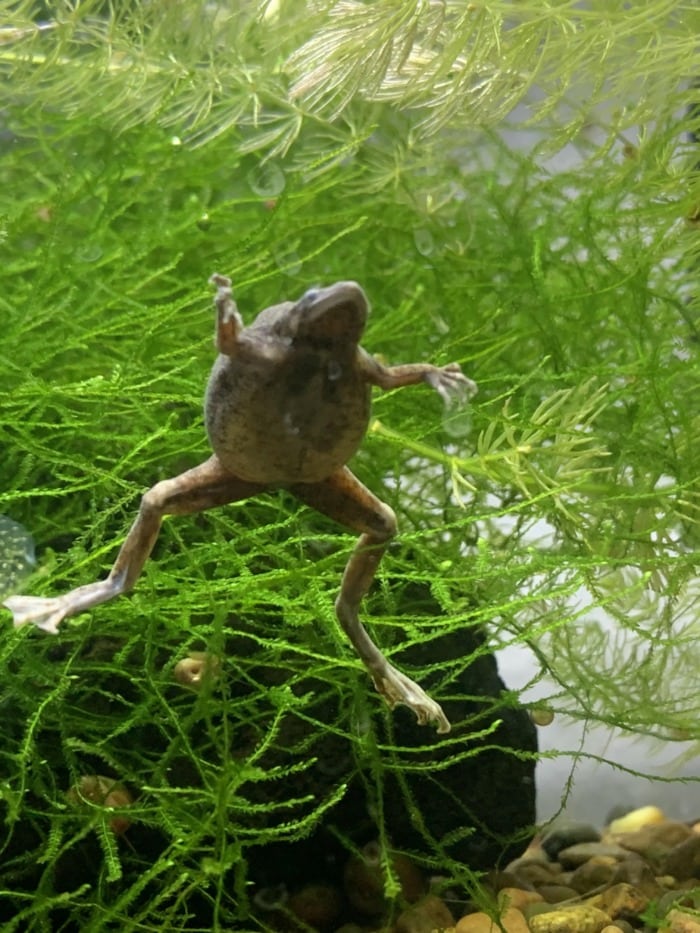
Finding your frog swollen like a balloon and floating in your home aquarium may seem funny at first.
However, your inflated pet is likely suffering a life-threatening illness.
In this article, I’ll go over the main reasons behind an African clawed frog that has become bloated.
Furthermore, I’ll let you know how you can treat your puffy frog’s sickness and save its life.
So let’s dive in!
Why is my African clawed frog bloated?
There are several reasons why your albino or greenish African Clawed Frog may be bloated.
The information in this article applies to both the African Clawed Frog (Xenopus laevis) and its smaller cousin from the Hymenochirus genus – the African Dwarf frog.
An African Clawed Frog gets swollen due to a disease that affects its lymphatic system, known as Edema or Dropsy. The illness hinders the natural Osmoregulation of the animal and causes liquid buildup. This condition leads to severe bloating of the frog’s body and limbs.
The frog’s organism is unable to process and discharge the liquids.
The fluids would eventually start to enter the internal organs, which may kill the frog.
Therefore a bloated African Clawed Frog with dropsy should be treated in the early stages of the disease.
An amphibian in such a condition would start acting in unusual ways.
It may stop eating, get moody, or may even stop moving, and simply float weightlessly in the aquarium, sometimes even upside down.
What causes Dropsy in African Clawed and Dwarf frogs?
Osmoregulation is the process that controls how much liquids the body of an animal absorbs and how much it releases.
There are several cases where Dropsy affects Osmoregulation in frogs and becomes a problem.
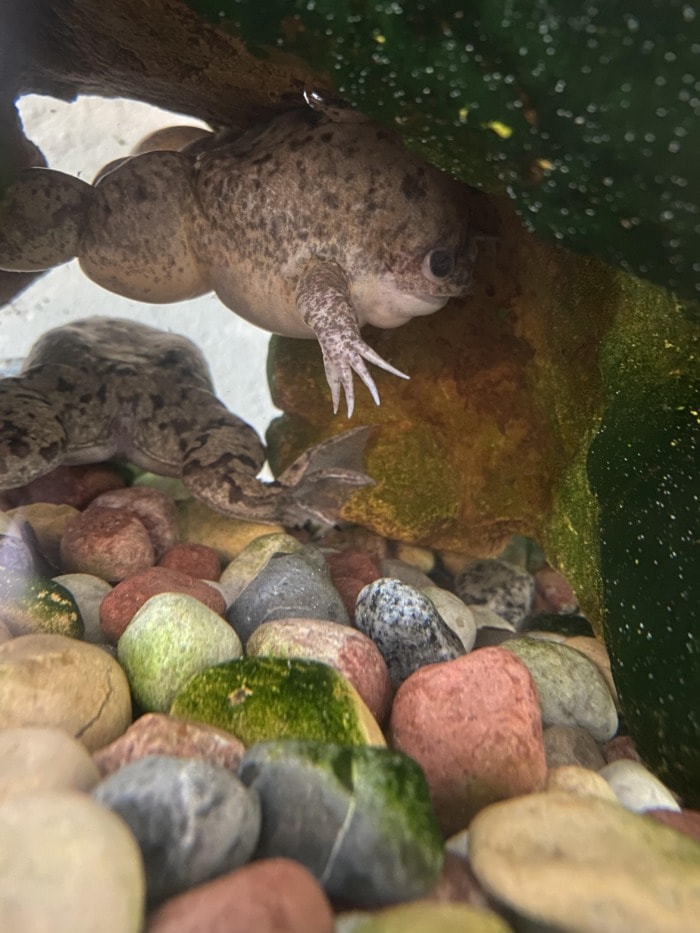
However, it may be hard to determine the exact reason why your aquatic pet may be inflated.
Here are the most common causes of dropsy in African Clawed frogs:
1. The water in the aquarium is too soft
A study I’ve found suggests that keeping your African or Dwarf Clawed frog in water that’s on the soft end for too long can cause issues. Some people mistakenly use distilled water in their frog aquarium, thinking that it’s the purest possible solution.
However, distilled water is the softest type of water out there.
These frogs are naturally adapted to the hard waters of the African Rift Valley, where they come from.
This means that the frog’s internal Osmoregulation is suited to “oppose” the osmotic pressure of hard water.
Keeping your African Clawed frog in the wrong water hardness can potentially damage the mechanism that controls how much liquid its body holds.
Eventually, the mechanism stops working properly and the frog begins to bloat, holding too much water.
Unfortunately, when the bloated frog is affected by this type of Dropsy, full recovery is likely impossible.

A bloated African Clawed Frog would often have Septicemia, also known as Sepsis.
This is a clinical term for blood poisoning by bacteria.
It’s not known how this condition can lead to bloating.
In this case, it is likely best to take your frog to the vet.
3. Organ failure
The kidneys are responsible for controlling the liquid exchange in African Clawed frogs, including the Dwarf variety.
Kidney or liver abnormalities and infections can sometimes end up in impaired Osmoregulation for the frog.
The infections may be caused by bacteria and abnormalities by a birth defect.
4. Skin disease
Frogs don’t drink water like us humans.
They absorb it through their skin and rely on that for their electrolyte exchange.
However, sometimes African Clawed frogs develop skin diseases that affect their fluid absorbtion. This leads to electrolyte imbalance and fluid retention.
In this case, the frog is no longer able to absorb electrolytes from the large amounts of fluid it takes in.
The electrolytes are expelled with the urine, but the frog holds most of the fluid in its body.
5. Impaired metabolism
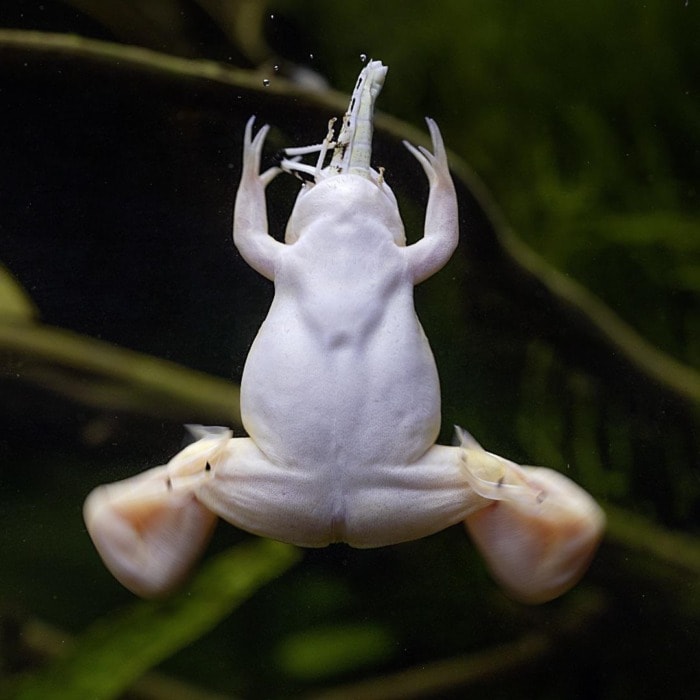
Often caused by overfeeding with heavy foods such as bloodworms or beef heart.
African clawed frogs are carnivores and love meaty foods such as frozen or freeze-dried bloodworms and brine shrimp.
Some owners would also feed their ACF with slices of liver and heart to get them in the mood to breed.
Nevertheless, if you go overboard with these types of food, the metabolism of your pet may suffer damage, resulting in bloat for the frog.
You should mainly feed your African Clawed Frog with commercially prepared pellets and wafers.
Meaty foods should only be an occasional treat.
How to help and treat bloated African clawed frogs?
There are actually two types of swelling in African Clawed Frogs – soft bloat and hard bloat.
If your pet frog’s inflated body feels puffy like a water balloon, then you’re dealing with soft bloat.
If the inflamed body of your pet is firm to the touch like the inside of your wrist – then you’re dealing with hard bloat.
While both conditions require immediate treatment, the latter is harder to cure and can often be fatal.
Nevertheless, you shouldn’t give up, as it’s not impossible to save your swollen ACF, even if it’s suffering from hard bloat. Of course, your best course of action would be to take your pet frog to the veterinarian.
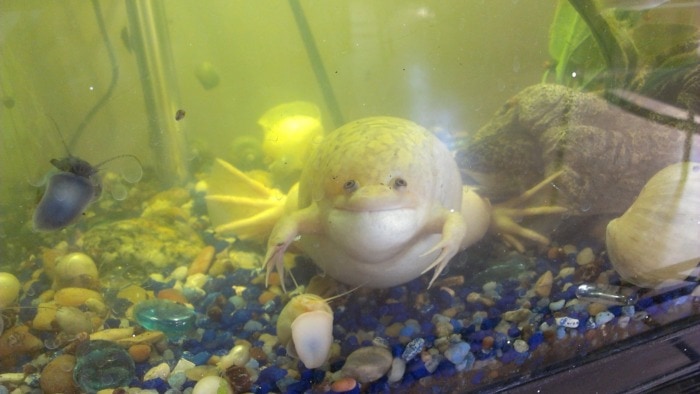
Other than that, you can follow these steps to help and treat your bloated African Clawed Frog:
- Set up a quarantine tank (QT) for your sick pet. If the African Clawed Frog is the only aquarium inhabitant, it can remain in its original tank during treatment – no QT needed.
- Start antibiotic treatment. You’ll want to do this in case your frog’s condition is caused by a bacterial infection to the kidneys. You can use products, such as Maracyn II, Maracyn Plus, or Enrofloxacin. When it comes to dosing – follow the recommendations on the product’s label. If you end up using Enrofloxacin, put the frog on a wet paper towel and put the medicine (0.5mg/ml) on its back for 30 minutes twice a day. I usually do this once in the morning, and once in the evening, 12 hours apart. Do this for two weeks and monitor your frog’s body for changes.
- Add a product that helps with recovering the slime coat of your frog to the tank. Something like Api Stress Coat Plus can be used for the purpose and you can add it to the quarantine tank. It will help to restore the protective slime coat of your amphibian, which in turn can improve its osmoregulation.
- Do daily salt baths in a separate container. Use 1/4 of a teaspoon of unscented Epsom salt or aquarium salt and 2 cups of spring water. Do not use table salt. Let the African Clawed Frog remain in the salty water for 15 to 20 minutes.
While your pet is in a quarantine tank, you can clean your main aquarium thoroughly, including rockwork and decorations, and perform a water change.
You should do this because the bloat of your frog may be caused by a bacterial infection.
Providing clean water and making sure that the water parameters are in check can prevent future bacterial infections.
What should you expect of your frog during its Dropsy treatment?
Treating frog bloat can take a while. You should be persistent in your effort to cure your swollen pet. If you don’t notice any improvement after 10 to 14 days, your African Clawed Frog may be too sick and unable to beat the disease. If that’s the case it may survive for a couple of weeks to about a year. The sooner you start the treatment – the higher the chance of success.
With all being said, the best approach to treating an African clawed frog with dropsy is to take it to a vet.
The qualified specialist will prescribe the most efficient treatment for your aquatic pet.
Furthermore, if necessary, the qualified veterinarian can drain the bloated ACF by using a needle – a procedure that you shouldn’t try to perform yourself.
Tips to prevent Dropsy in African Clawed Frogs?
There are a couple of steps that you can follow to prevent Dropsy from affecting your African Clawed frogs in the future:
- Do some research on the water hardness your frog prefers to dwell in. African Clawed Frogs live in hard water in their natural habitat. Water that’s too soft can mess up the internal mechanism of a frog to regulate how much fluids its body can hold.
- Keep the water in the tank clean. Dirty aquarium water can easily become a breeding ground for bacteria that can harm your frog and its kidneys. Properly working kidneys will regulate fluid retention in frogs.
- Be sure to monitor your frog for skin conditions. Take the frog to a qualified vet if anything abnormal pops up.
- Feed your African Clawed frog with high-quality foods. Don’t simply go for the cheapest brand of frog food. Make an effort.
Final words
A while back a friend of mine called me concerned about her albino African Clawed Frog being bloated and acting weird.
Initially, she was wondering whether her pet could be pregnant with eggs or bloated with dropsy.
African Clawed Frogs don’t breed easily in captivity which makes it very unlikely that a bloated frog is carrying eggs.
Furthermore, a female’s behavior wouldn’t change so drastically if she was carrying eggs.
After I gave her the dropsy treatment tips that I described above, she managed to cure her pet’s disease and it’s alive to this day.
I hope that you found my article helpful.
Leave me a comment below if you have further questions!



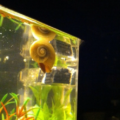


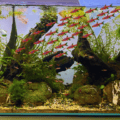
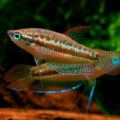

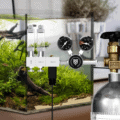


Is it possible that the salt bath is actually making my frogs condition worse?! He looks more bloated than he did… but I’m only on the second day of salt bath treatment.. I work at an environmental lab and am going to take my tank water in for testing
Hello,
Salt baths are used to “draw” the built-up liquids from under your frog’s skin and body through osmotic pressure.
No salt baths!! The info in this piece is absolutely wrong. The reasons for bloat are correct. But the treatments are absolutely NOT. No salt for amphibians. No stress coat. That’s for fish. Not frogs. And no needles to remove fluid- it will only return again and can harm the frog. Blood worms should never be used as they can cause the bloat. Please no more salt.
Could you give me a source for your claims?
I consulted with a vet who had a lot of experience with aquatic amphibians for this piece.
You’re likely confusing land-based or semi-aquatic frogs with aquatic species. There’s a huge difference in osmoregulation mechanisms in these animals and thus how salt affects them.
Stress Coat is a water conditioner, not a fish conditioner. Essentially, we keep water, not fish. It helps with slime coats for all aquatic animals that have such. No one ever reported their frogs being harmed by it – just the opposite, in fact.
Vets use needles for providing immediate relief to the frog. How could you recommend against that? It’s evidently treating the symptom and not the problem itself, but it helps your pet frog feel better. Where in my article did you read it’s a one-off solution to the underlying cause of the bloat?
And finally – no bloodworms for African dwarf frogs? These frogs are carnivores, meaning their stomach has adapted to decompose meat and fiber from the chitin in insects. If it was a food problem the bloat would only be located on the belly and it would be caused by constipation. In the case of dropsy bloat, however, the whole body of the frog swells, meaning it’s an issue with osmoregulation.
So in three sentences, you managed to make three false claims, while simultaneously jumping to conclusions about my piece.
Please try to be moderate with your opinions when talking about unfamiliar subjects.
Best,
Momchil